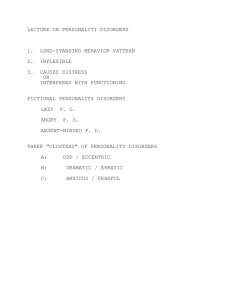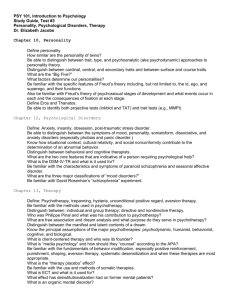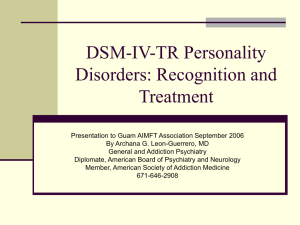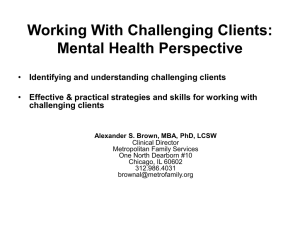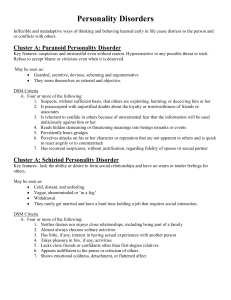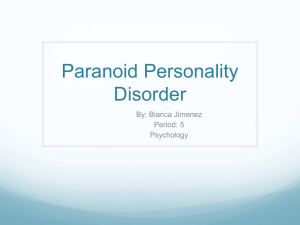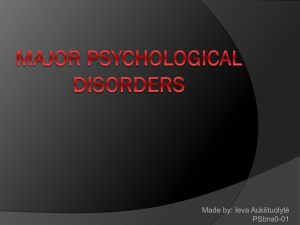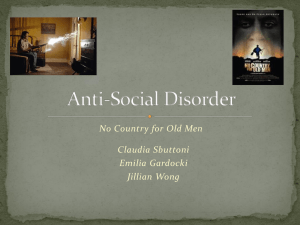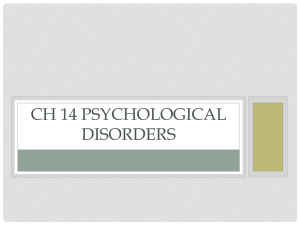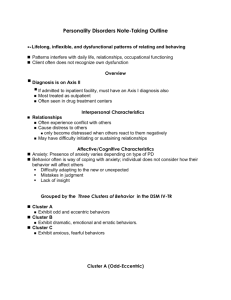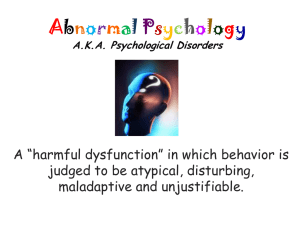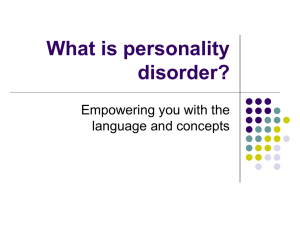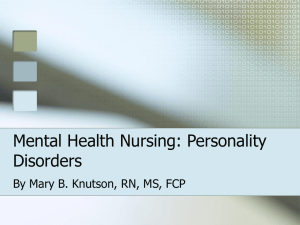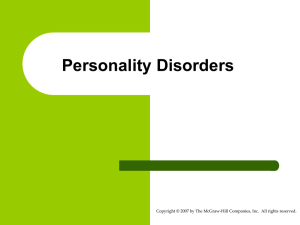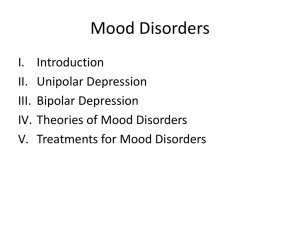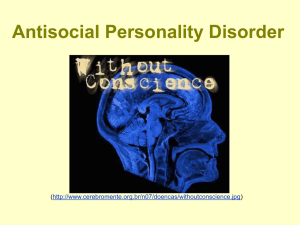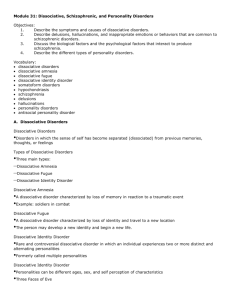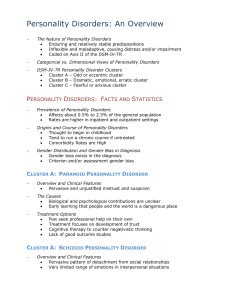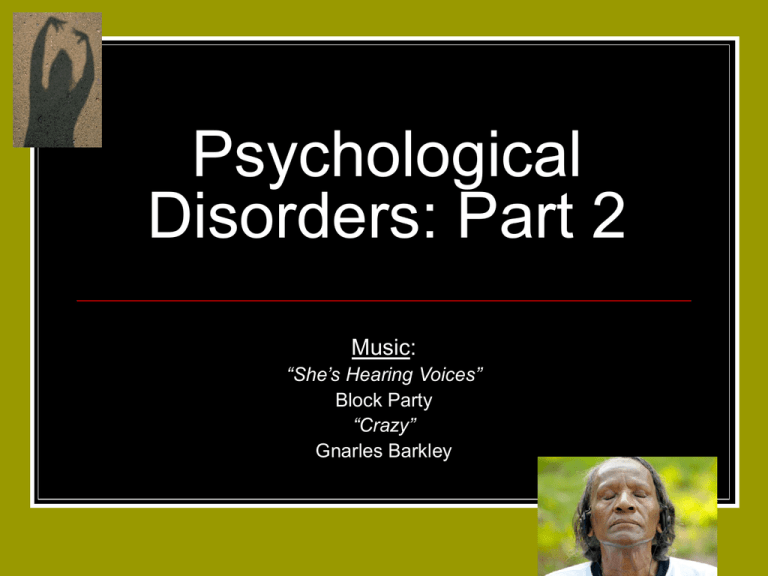
Psychological
Disorders: Part 2
Music:
“She’s Hearing Voices”
Block Party
“Crazy”
Gnarles Barkley
Today’s Agenda
1. Schizophrenic Disorders
a) Symptoms
b) Movie: “The New State Asylums” (online)
http://www.pbs.org/wgbh/pages/frontline/shows/asylums/
c) Theories
2. Personality Disorders
a) Cluster A:
b) Cluster B:
E.g. Borderline, Antisocial
c) Cluster C:
E.g. Paranoid
E.g. Obsessive-Compulsive, Avoidant
3. Quiz Questions
4. Movie: Home Videos and Schizophrenia (6 min.)
1. Schizophrenic Disorders
Schizophrenia
“Split Mind”
Not a multiple personality disorder, but a thought disorder
1. a) Symptoms:
1. Disturbed Thought Content
Delusions: Grandiose or Persecutory
Expression is bizarre (e.g. loose associations/ poverty of speech)
2. Hallucinations and Disturbed Behaviour
E.g. hearing voices/ speaking to imaginary people
Agitation or catatonic stupor http://www.youtube.com/watch?v=_qCcSQPh2Bc
3. Disturbed Emotions
E.g. laughing inappropriately/ blunted, flat affect
4. Deterioration in Functioning
E.g. Neglect of personal hygiene, social withdrawal
1. b) Prisons: The New State
Asylums
Frontline Show Available Online
Note: 2 multiple choice questions extracted from segment shown in
class will be on the final)
http://www.pbs.org/wgbh/pages/frontline/shows/asylums/
1. c) Theories of Schizophrenia
•
Genetic Contribution: (p. 635)
1. c) Theories of Schizophrenia
•
Genetic Contribution: (p. 636)
•
•
•
But what is inherited?
Excess dopamine:
Evidence:
•
•
•
Drugs that increase dopamine produce symptoms similar to
schizophrenia
Anti-psychotic drugs that decrease dopamine activity lessen
schizophrenic symptoms
Epigenetics:
•
Study of chemical changes to a gene that influence its
expression
•
•
(without altering DNA sequence)
1/200 genes of psychotic patients show epigenetic differences
•
For genes involved in neurotransmission & brain development
•
14.19, p. 636
2. Personality Disorders
DSM-IV Definition:
Inflexible, enduring patterns of behavior that create impairment in
functioning (especially conflict with others) and/or subjective
distress
Cluster A: Odd-Eccentric
Distrustful, socially aloof, unable to connect with others
schizoid, schizotypal, paranoid
Cluster B: Dramatic/Impulsive
May involve up to 15% of population
Self-centered, (overdramatic), low impulse control
histrionic, narcissistic, anti-social, borderline
Cluster C: Anxious/Fearful
Maladaptive efforts to control anxiety
dependent, obsessive-compulsive, avoidant
2. Personality Disorders:
A) Cluster A: Paranoid: (4%)
Suspects (without sufficient basis) that others are exploiting, harming,
or deceiving him or her
Tends to be angry or hostile
Is preoccupied with unjustified doubts about the loyalty or
trustworthiness of friends or associates
Perceives attacks on his or her character that are not apparent to
others and is quick to react angrily
Has recurrent suspicions, without justification, regarding the fidelity of
spouse or partner
Avoids confiding in others for fear of betrayal
2. Personality disorders
(cont’d)
2. b) Cluster B: Borderline: (2%)
20% of psychiatric patients
Frantic efforts to avoid real or imagined abandonment
A pattern of unstable and intense interpersonal relationships
Emotions spiral out of control, leading to extremes of anxiety,
sadness, rage
Recurrent suicidal behavior, gestures or threats or selfmutilating behaviour
Identity disturbance, unstable self-image or sense of self
Impulsivity in at least 2 areas (e.g. spending, sex, substance
abuse, reckless driving, binge eating)
2. Personality Disorders
(cont’d)
Antisocial: (3%)
Antisocial behaviors; violate the rights of others without shame or
regret
i.e. Takes advantage of others; is out for number one
Superficial charm but deceitful, using lies to con others
Callous; no remorse
Irritable and aggressive, as indicated by repeated physical fights
or assaults http://www.youtube.com/watch?v=B2fjkWIUjS8
Onset before age 15 (conduct disorder)
Most promising cause:
Biological predisposition (limbic and frontal lobe abnormalities)
Combined with neglect and abuse
2. Personality Disorders (cont’d)
2. c) Cluster C: Obsessive-compulsive: (8%)
Preoccupied with rules, details, organization, to the point
where the major point of the activity is lost
Perfectionism that interferes with task completion
Excessively devoted to work and productivity to the
exclusion of friendships or leisure activities
Show rigidity and stubbornness
Reluctant to delegate tasks or to work with others unless
they submit exactly to his way of doing things
2. c) Cluster C: (cont’d)
Avoidant Personality Disorder: (2%)
Avoids occupational activities that involve significant
interpersonal contact, because of fears of criticism, disapproval,
or rejection
Views the self as socially inept, inadequate, or inferior to others
Is preoccupied with being criticized or rejected in social
situations
Fear of being shamed or ridiculed
3. Review Quiz
For each case presented below, select a possible diagnosis according to
the following choices:
A) Social anxiety
D) Hypochondriasis
B) Obsessive Compulsive Disorder E) Somatoform Disorder
C) Generalized anxiety disorder
F) Agoraphobia G) None of the above
Wesley has gone in for a psychiatric assessment. He tells the clinician the
he has been feeling apprehensive and edgy for the last month, but so far
his anxiety hasn’t interfered with his job or home life.
Doris feels terrified every time she leaves her house, and avoids doing so
whenever possible.
Kate constantly thinks about jumping in front of an oncoming car when she
is walking. The only way she seems to be able to stop these selfdestructive thoughts is to say Mother Goose nursery rhymes over and over
to herself.
Laura takes over 40 different vitamins and herbal remedies each day to
keep herself in top physical health. Recently she had some severe
dizziness, but her family doctor assured her that is was just a minor ear
infection that would clear up in a few days. Laura is concerned because
she is sure the ear infection is the sign of something much more serious,
such as a brain tumor, and she has made appointments with three different
specialists to have more testing done.
3. Review Quiz (cont’d)
For each case, select the most appropriate personality style:
A) Avoidant
C) Paranoid
E) Antisocial
B) Borderline
D) Obsessive Compulsive
Sophia has always been preoccupied with schedules, lists, and trivial details.
She plans everything sown to the last detail and becomes very upset if things
don’t work out the way she has planned.
In the past 9 months Andrew has been fired by three different employers. He
was unreliable and often missed work, and each employer finally let him go
when they found he had been stealing money and materials. Andrew feels no
remorse over his actions, but he has managed to convince each of his former
employers that he is sorry for his actions, and none plan to press any charges.
Ellen is has been feeling both depressed and anxious. She would like to be in a
relationship but feels that it is out of her reach. She becomes unbearably
anxious in new social situations and does not see how she will ever be able to
approach or speak coherently to someone of the opposite sex.
Roy alternates between periods in which he remains motionless and seems
oblivious to his environment, and periods of hyperactivity and frenzied
excitement. He seems to be responding to voices in his head.
4. Movie (if the CD player will let me)
“Home Videos and Schizophrenia”
Can we learn to predict who will develop schizophrenia? In this
video, students see how psychologists are using low-tech
procedures like home videos, and high-tech procedures like
hormonal measure and brain scans to better understand who
might develop this very serious mental health disorder.
(6 min.)

